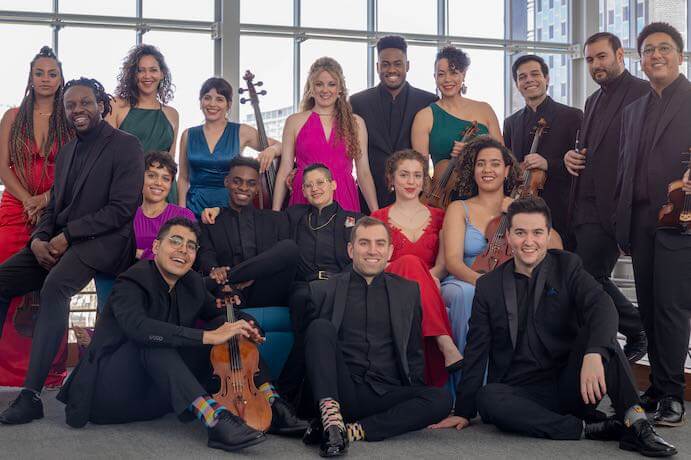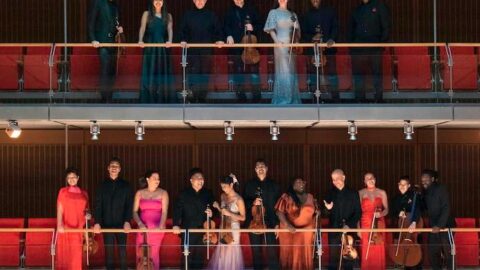Released July 28 on Deutsche Grammophon, the Sphinx Virtuosi’s Songs for Our Times is sprawling, contradictory, and wonderful. Filled with both the powerful and playful, the album — part celebration, part indictment — looks backward while suggesting ways forward. The Sphinx Virtuosi are the all-Black and Latine touring ensemble of the Sphinx Organization, and the album similarly features the work of Black and Latine composers… and Beethoven, in arrangement. The collection of pieces presents the ensemble in as full a breadth as can be managed in one album, making for a strong, distinct debut.
The title of Michael Abels’ Global Warming was originally a reference to the end of the Cold War, but has taken on additional meaning with time. The jaunty tune gradually moves through many different styles in a multicultural exploration that celebrates the thawing of international relations. The work, however, is slightly diminished in this strings-only arrangement, losing some of the color that helps carry the momentum in the full-orchestra version.
Aldemaro Romero worked in film and concert music, and Fuga con Pajarillo clearly shows the influence of both. With the sound world of a Golden-Age Hollywood score, this fugal dance is equal parts sexy, lush, and refined. Romero seamlessly weaves subject and countersubject around each other over the Venezuelan dance, played tenaciously by the Sphinx Virtuosi, along with an incredible violin solo by Sandro Leal-Santiesteban.

Valerie Coleman’s Tracing Visions, one of the two works written specifically for the ensemble, is the emotional heart of the album. Coleman’s gorgeous orchestration pulls every bit of color from the string orchestra to bring this piece to life. The heartbreaking first movement, “Till,” is a reference to Emmett Till and other victims of domestic terrorism, such as Ruby Bridges and the children of the Uvalde massacre. The movement is mostly understated, and made more striking as a result. With only the slightest turn, Coleman pulls us into the deepest grief, but there is also a thread of warmth in this remembrance, which makes the moments of outright expression fiercely gripping. The second movement, “Amandla!” (Zulu for “power”), is an exuberant celebration of the Sphinx Organization. Featuring a primary motif that spells “Sphinx” in morse-code, the rhythmic vigor and melodic invention uplift the work that has and will be done.
Violinist Amaryn Olmeda shines in Carlos Simon’s Between Worlds, a character study of self-taught artist Bill Traylor with music at the intersection of “mythical folklore, race, and religion.” Olmeda’s dynamic expression and phrasing in the opening is nuanced, and her technical virtuosity is on full display in the jagged, rhythmic frenzy of the blues licks and chromatic modernism. A string orchestra arrangement of the “Andante Cantabile” from Florence Price’s String Quartet No. 2, with her signature blues-infused late Romanticism, pairs well with Simon’s work. But while both pieces share harmonic similarities, the character is vastly different in each. Price builds her “Andante” around a simple two-note ostinato, which starts sunny and bright, before darkening into the more dramatic and cold middle section.
Divided, by Jessie Montgomery, is the other Sphinx commission for the album, with Tommy Mesa providing a stirring performance of the solo cello part. Montgomery draws the main motive out of the first two notes with exquisite care, keeping tension high before expanding the texture. The piece becomes more frenetic — the resigned main motive growing more impassioned — and the ensemble breaks into distinct layers. Though each layer moves at a different pace, they wax and wane in the same general shape, only coming together during a series of stirring climaxes.

In Sísifo na Cidade Grande (Sisyphus in the Big City), Ricardo Herz sets a smooth, searching melodic line over an uneven meter, providing an off-kilter, but not unnatural feel to the music. This highly effective pairing makes for a sleek, engaging work that’s effortlessly cool and never boring, especially with a leisurely middle section that creates a sensation of time slowing down.
The final piece is an arrangement of the third movement of Beethoven’s Violin Sonata No. 9 that addresses a bit of history — namely, its dedication. Arranger Rubén Rengel restores the original dedication to George Bridgetower, a British violinist of African descent for whom Beethoven had written the piece. After a falling out with Bridgetower, Beethoven changed the dedication to Rodolphe Kreutzer, who notably never performed the work. The arrangement for string orchestra strengthens the original, the imitative lines now jumping around the strings in a propulsive cascade of energy. The Sphinx Virtuosi tackle a difficult task with incredible skill, without losing any of the lightness or agility that define the original despite the much larger ensemble.
Contrasting threads run throughout Songs of Our Times: the feelings of hopelessness, sorrow and despair at what we see around us, but also moments of joy and the celebration of what has been achieved. But the overriding sentiment is of celebration and hope, of the sense that if good has been done, then good can be done still — that things can be made better. In looking back at the strength and courage of those who have come before us, we might find some of our own, enough to push back on the tides of dejection and despair and keep trying.
I CARE IF YOU LISTEN is an editorially-independent program of the American Composers Forum, and is made possible thanks to generous donor and institutional support. Opinions expressed are solely those of the author and may not represent the views of ICIYL or ACF.
You can support the work of ICIYL with a tax-deductible gift to ACF. For more on ACF, visit the “At ACF” section or composersforum.org.
























